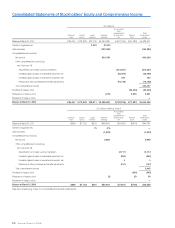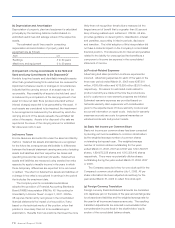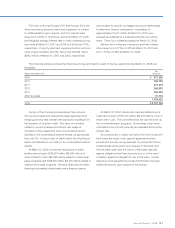Honda 2008 Annual Report Download - page 75
Download and view the complete annual report
Please find page 75 of the 2008 Honda annual report below. You can navigate through the pages in the report by either clicking on the pages listed below, or by using the keyword search tool below to find specific information within the annual report.
A n n u a l R e p o r t 2 0 0 8 7 3
balance sheets in prior years under the income statement
approach. The net impact of these adjustments decreased
Honda’s beginning retained earnings and beginning
accumulated other comprehensive loss for 2007 by ¥62,640
million, net of tax effect of ¥31,235 million, and ¥18,149
million, respectively, for the items described below:
1. The Company and its certain domestic subsidiaries in
Japan historically calculated depreciation of property, plant
and equipment, using a salvage value determined as 5%
of the acquisition cost. However, since the sales proceeds
received for the liquidated assets and their economical value
at the end of its useful life historically have been nominal, the
Company and its certain domestic subsidiaries assessed
the adequacy of the salvage value and concluded that
they should have calculated depreciation using the salvage
value of ¥1 for its property, plant and equipment. The
Company and its certain domestic subsidiaries recalculated
depreciation expenses retrospectively considering the
corrected salvage value. The reassessment indicated that
an accumulated overstatement of property, plant and
equipment in the consolidated financial statements had
occured.
2. Equity in income of affiliates should be recognized based
on affiliates’ consolidated financial statements in accordance
with U.S. generally accepted accounting principles.
However, the Company historically recognized equity in
income of affiliates based on the results of operations of
the parent-only financial statements of the affiliates, as the
Company assessed that the difference between the total
amounts of equity in income on the consolidation basis and
those on the parent-only basis had been immaterial to the
Company’s consolidated financial statements under the
income statement approach. This misstatement resulted
in an accumulated understatement of equity in income of
affiliates and the carrying value of the investments in affiliates
in the consolidated financial statements.
3. The Company reclassified the residual tax effect of
minimum pension liabilities included in accumulated other
comprehensive income during the year ended March 31,
2006, which related to corporate tax rate changes in the
past based on the proportional allocation over the expiration
of unrecognized obligation. However, the residual tax effect
should have been reclassified only when the pension plan
is liquidated or dissolved under the portfolio approach. This
misstatement resulted in an understatement of accumulated
other comprehensive loss and corresponding overstatement
in income tax benefit.
(v) Reclassifications and Revisions of Classifications
Certain revisions for misclassifications and reclassifications
have been made to the prior years’ consolidated financial
statements to conform to the presentation used for the
fiscal year ended March 31, 2008. Detailed information is
provided in note 3.
3. Revisions of Classifications
Certain revisions for misclassifications have been made to
the prior years’ consolidated financial statements.
(a) Investor level goodwill in affiliates, which was classified
as other assets, has been revised to be classified as
investments in and advances to affiliates. The impact of
this revision in the consolidated balance sheets resulted in
an increase in investments in and advances to affiliates and
a corresponding decrease in other assets in the amount of
¥9,799 million at March 31, 2007.
(b) The long-term portion of deferred tax assets related to
pension benefit plans, which was classified as deferred
income taxes at March 31, 2007, has been revised to be
classified as other assets. The impact of this revision in the
consolidated balance sheet resulted in an increase in other
assets and a corresponding decrease in deferred income
taxes in the amount of ¥59,782 million at March 31, 2007.
2. Basis of Translating Financial Statements
The consolidated financial statements are expressed in
Japanese yen. However, the consolidated financial
statements as of and for the year ended March 31, 2008
have been translated into United States dollars at the rate of
¥100.19 = U.S.$1, the approximate exchange rate prevailing
on the Tokyo Foreign Exchange Market on March 31, 2008.
Those U.S. dollar amounts presented in the consolidated
financial statements and related notes are included solely
for the reader. This translation should not be construed
as a representation that all the amounts shown could be
converted into U.S. dollars.
























